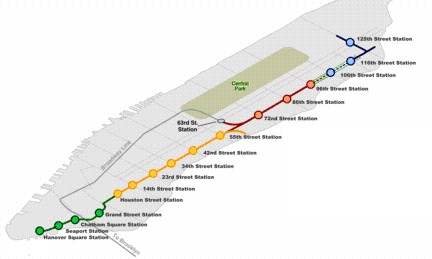
The MTA held a ritual groundbreaking today for the Second Avenue Subway (SAS). Depending on how you count, it was either the third, fourth, or fifth time since the 1920s that a subway line along Second Avenue has been proposed, but not built.
In the 1920s, there were elevated lines along Second and Third Avenues. Those lines were torn down on the premise that the SAS would replace them. Without the SAS, the Lexington Avenue Line is the city’s only rapid transit option on the East Side. The Lex is already over-capacity, and there are many parts of the city where there’s a very long walk to the Lex.
As now planned, the line is expected to be built in four phases. Phase I, which won’t open till 2013, adds just four new stations to the  service: 96 & 2nd, 86th & 2nd, 72nd & 2nd, and 63rd & Lex. That’s six years to build four stations. It’s actually worse than that, because the station at 63rd & Lex already exists: it’s “hiding” behind a partition wall at the 63rd & Lex
service: 96 & 2nd, 86th & 2nd, 72nd & 2nd, and 63rd & Lex. That’s six years to build four stations. It’s actually worse than that, because the station at 63rd & Lex already exists: it’s “hiding” behind a partition wall at the 63rd & Lex  station.
station.
Phase II would extend service up to 125th & Lex, with stations at 106th Street, 116th Street, and 125th Street. This ought to be one of the easier phases to complete, because it uses two large tunnel sections that were built in the 1970s, the last time there was serious work done on this project.
Phase III, the largest phase, would add stations at 55th, 42nd, 34th, 23rd, 14th, and Houston Streets. Phase IV would complete the line down to Lower Manhattan, with stops at Grand Street, Chatham Square, Seaport, and Hanover Square. When completed, letter  would be used for the trains running the full length of Second Avenue. But there will be no
would be used for the trains running the full length of Second Avenue. But there will be no  until after Phase III, which could be decades from now.
until after Phase III, which could be decades from now.
The catch is that funding is in place only for Phase I—and in fact, the project is still about $1 billion short. Given the history of this line, one has to be skeptical about where the funds for Phases II–IV will come from.
There’s another catch. A few years ago, transit officials argued that the extension of the  to 96th Street was as far as the line needed to go. This initial plan was widely regarded as inadequate—skeptics called it a “stubway”—and that led directly to the current plan for a full-length SAS. But some have cynically suggested that the later phases are just a ruse. After Phase I is built, the MTA will announce, with crocodile-tear sadness, that alas there are no funds to complete the full line.
to 96th Street was as far as the line needed to go. This initial plan was widely regarded as inadequate—skeptics called it a “stubway”—and that led directly to the current plan for a full-length SAS. But some have cynically suggested that the later phases are just a ruse. After Phase I is built, the MTA will announce, with crocodile-tear sadness, that alas there are no funds to complete the full line.
Until now, State Assembly Speaker Sheldon Silver, who represents Lower Manhattan neighborhoods that would benefit from the line, has been one of its strongest advocates. But Silver can only do so much, and at the glacial pace that transit projects usually take to materialize, he may no longer be around when it comes time to pony up for the later phases.
Some transit advocates are skeptical about the spacing of the stations. The SAS will be the only north–south line in the city without express service. There are several particularly long gaps, such as 86th to 72nd; 72nd to 55th; 55th to 42nd; and 14th to Houston. The design is a hybrid, with stations closer together than the typical express, but farther apart than the typical local. There could come a day when transit officials regret that decision.
For now, let’s be happy that at least part of the SAS is on the way. Coming to a theater near you in 2013.
 Thursday, July 3, 2008 at 08:41AM
Thursday, July 3, 2008 at 08:41AM 


 Transit
Transit 






